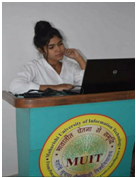The Evolution and Development of Alternative Dispute Resolution (ADR) in India and its Different Kinds
The authors of this blog are Mr. Vivek Yadav and Ms. Isha Baloni of Maharishi University of Information Technology, Noida.
INTRODUCTION
Alternative
Dispute Resolution is a procedure for settling disputes outside the court. It
costs less than the litigation process. People nowadays prefer ADR because it
allows two parties to interact and understand each other. It also allows the
parties to resolve problems easily which cannot be allowed by courts to legally
impose. ADR also intends to reduce stress and formality of going to court but
some people hire attorneys to represent them in ADR proceedings. Arbitrators
and Mediators are often lawyers and so, they hire a single lawyer to act as an
impartial third party to guide their resolution and ensure that the solution
for their problems is obtained which are beneficial for them. The rising
popularity of ADR day by day is rising as it is much cheaper than litigation.
Some of the parties now desire to solve their conflict and have great control
over their selected individuals who will decide their dispute and so now they
prefer ADR over litigation. Even, nowadays, it is mentioned in their clause that
they will prefer ADR in case any dispute arises.
BACKGROUND
Before starting anything first we have to know
how it originated. ADR (Alternative Dispute Resolution) is nothing new but an
informal quasi judiciary
system. Different forms of ADR have been in existence for thousands of
years. It was first passed in 1698 under
William III. This act was made to render the arbitrators in all cases for
controversies by merchants and traders. Its main aim is to empower the courts
to stay an action in court if the parties had agreed to take the dispute to
arbitration. The Arbitration Act
1940 gifted several steps to be taken to agree on disputes between the
parties: The parties appoint arbitrators court may also appoint arbitrators if
the parties fail to do so; Decide the disputes informally, Make an award, Or
settle the dispute by mediation, Compromise or any other matter; Court passes a
decree in tams of the award that found the decision was made properly, and
Arbitration Tribunal shall be competent m appoint an expert or legal advisor to
submit a report to at a specified question or assessor for assisting it on
technical matters. Arbitration Act
1950, there was a consolidation of the Arbitration Act 1889 and 1934. It included the power of a
court to stay actions where there was an applicable arbitration agreement.
Also, the Arbitration Act 1975 gave effect to the New York Convention on the
Recognition and Enforcement of Foreign Arbitral Awards.
POSITION OF ALTERNATE DISPUTE RESOLUTION IN
ANCIENT INDIA
Dispute resolution
outside of courts is not new, societies and the world over have long used non-judicial,
indigenous methods to resolve conflict what is new is the extensive promotion
and proliferation of ADR models, wider use of court connect ADR, and the
increasing use of ADR as to tool to realize goals broader than the settlement
of the specific dispute. The Alternate Dispute Resolution system is not a new
experience for the people of this country also. It has been prevalent in India
since time immemorial. Legal history indicates that down the ages man has been
experimenting with the procedure for making it easy, cheap, unfailing, and
convenient to obtain justice. The ancient system of dispute resolution
made a considerable contribution, in resolving disputes relating to family,
social groups, and also minor disputes relating to trade and property. Village
level institutions played the leading role, where disputes were resolved by
elders, comprising council of village, popularly called Panchayat. The ancient
system of dispute resolution made a considerable contribution, in reaching a
resolution of disputes relating to family, social groups, and also minor
disputes relating to trade and property. Village level institutions played the
leading role, where disputes were resolved by elders, comprising council of
village, popularly called Panchayat[1].
MODES OF ALTERNATE DISPUTE RESOLUTION
There are 3 types of ADR
●
Mediation
●
Conciliation
●
Arbitration.
ALTERNATE DISPUTE RESOLUTION IN INDIA
·
ARBITRATION: -It is a procedure in which a dispute is submitted to an
arbitral tribunal by which it makes a decision that is binding to the parties.
It is an informal process of trial for disputes. There are four essentials in
Arbitration: -
· Arbitration Agreement,
· a dispute,
· a reference to a third party for
its determination, and
· an award by a third party
THERE ARE
4 TYPES OF ARBITRATION:-
1. Ad Hoc Arbitration
2. Institutional Arbitration
3. Statutory Arbitration
4. Fast track Arbitration
●
MEDIATION: - It is a process in which a mediator resolves the dispute
between two parties by sitting with them informally and identifies the disputed
issues, explore options, consider alternatives and try to reach an agreement.
It is a face to face meeting with all the disputants and one or more mediators.
In some cases, people sit in different rooms and the mediator converse them
separately and acts as a messenger between them.
●
CONCILIATION:- A conciliator may have
professional expertise in the matter of dispute so that he can give good advice
about the dispute and alternatives for resolution. A conciliator is one who can
only give his advice; he cannot make decisions
or judgment about the dispute. Conciliation is suitable if one wants assistance
with mediation, wants to decide democratically, wants advice on the facts of
the dispute, or wants to agree on some technical and legal issues.
●
NEGOTIATION:- It generally refers to
self-counseling. It’s a type of compromise between two parties to resolve the
conflicts.
CONCLUSION
The procedures and techniques
discussed above are the most commonly employed methods of ADR. Negotiation
plays an important role in each method, either primarily or secondarily.
However, there are countless other ADR methods, many of which modify or combine
the above methods. For example, it is not uncommon for disputants to begin
negotiations with early neutral evaluation and then move to nonbinding
mediation. If mediation fails, the parties may proceed with binding
arbitration. The goal with each type of ADR is for the parties to find the most
effective way of resolving their dispute without resorting to litigation. The
process has been criticized as a waste of time by some legal observers who believe
that the same time could be spent pursuing the claims in civil court, where
negotiation also plays a prominent role, and litigants are protected by a
panoply of formal rights, procedures, and rules. But many participants in
unsuccessful ADR proceedings believe it is useful to determine that their
disputes are not amenable to a negotiated settlement before commencing a
lawsuit. With the advent of alternate dispute resolution, there is a new avenue
for the people to settle their disputes. The settlement of disputes in Lok
Adalat quickly has acquired good popularity among the public and this has given
rise to a new force to ADR and this will no doubt reduce the pendency in law
Courts.





Comments
Post a Comment